The MSI Z170A SLI PLUS Review: Redefining the Base Line at $130
by Ian Cutress on April 13, 2016 8:00 AM EST- Posted in
- Motherboards
- MSI
- Skylake
- Z170
System Performance
Not all motherboards are created equal. On the face of it, they should all perform the same and differ only in the functionality they provide - however this is not the case. The obvious pointers are power consumption, but also the ability for the manufacturer to optimize USB speed, audio quality (based on audio codec), POST time and latency. This can come down to manufacturing process and prowess, so these are tested.
Power Consumption
Power consumption was tested on the system while in a single MSI GTX 770 Lightning GPU configuration with a wall meter connected to the OCZ 1250W power supply. This power supply is Gold rated, and as I am in the UK on a 230-240 V supply, leads to ~75% efficiency > 50W, and 90%+ efficiency at 250W, suitable for both idle and multi-GPU loading. This method of power reading allows us to compare the power management of the UEFI and the board to supply components with power under load, and includes typical PSU losses due to efficiency. These are the real world values that consumers may expect from a typical system (minus the monitor) using this motherboard.
While this method for power measurement may not be ideal, and you feel these numbers are not representative due to the high wattage power supply being used (we use the same PSU to remain consistent over a series of reviews, and the fact that some boards on our test bed get tested with three or four high powered GPUs), the important point to take away is the relationship between the numbers. These boards are all under the same conditions, and thus the differences between them should be easy to spot.
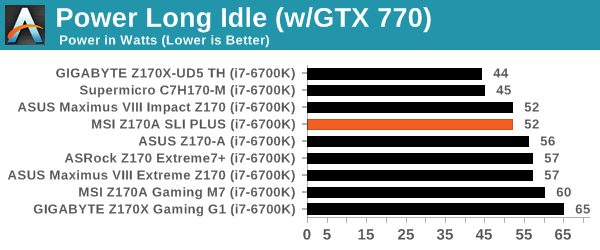
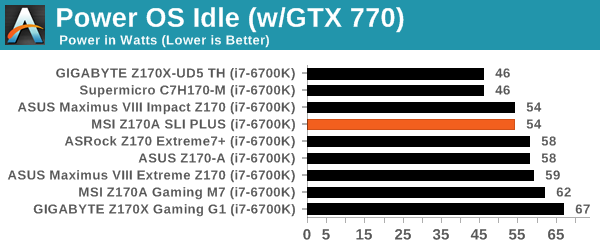

As a low cost motherboard, there are two ways a power reading can be interpreted. If it’s low, then due to the lack of controllers compared to the high end motherboards, this is to be expected. If high, then the power delivery might be a budget implementation with reduced efficiency. For the MSI Z170A SLI PLUS, we got an impressive 73W delta from long idle to load in our test, with the load power being the lowest we’ve seen on a Z170 motherboard so far.
Non UEFI POST Time
Different motherboards have different POST sequences before an operating system is initialized. A lot of this is dependent on the board itself, and POST boot time is determined by the controllers on board (and the sequence of how those extras are organized). As part of our testing, we look at the POST Boot Time using a stopwatch. This is the time from pressing the ON button on the computer to when Windows 7 starts loading. (We discount Windows loading as it is highly variable given Windows specific features.)
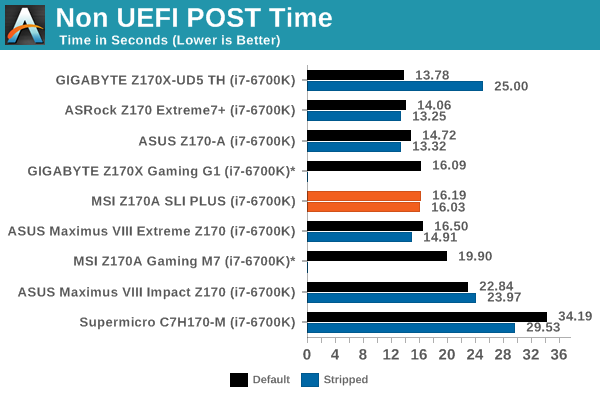
For whatever reason, when Z170 was launched there was a regression in POST times from most motherboard manufacturers. DDR4 training does take longer than DDR3 used to, but instead of sub 10-seconds being a good target, for Z170 anything under 15-seconds is good to see. The SLI PLUS floats on the 16 second boundary here, with not much change when the BIOS is stripped and controllers disabled.
Rightmark Audio Analyzer 6.2.5
Rightmark:AA indicates how well the sound system is built and isolated from electrical interference (either internally or externally). For this test we connect the Line Out to the Line In using a short six inch 3.5mm to 3.5mm high-quality jack, turn the OS speaker volume to 100%, and run the Rightmark default test suite at 192 kHz, 24-bit. The OS is tuned to 192 kHz/24-bit input and output, and the Line-In volume is adjusted until we have the best RMAA value in the mini-pretest. We look specifically at the Dynamic Range of the audio codec used on board, as well as the Total Harmonic Distortion + Noise.
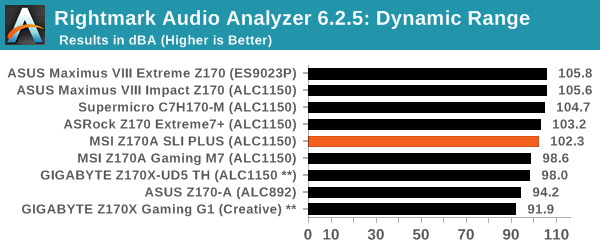
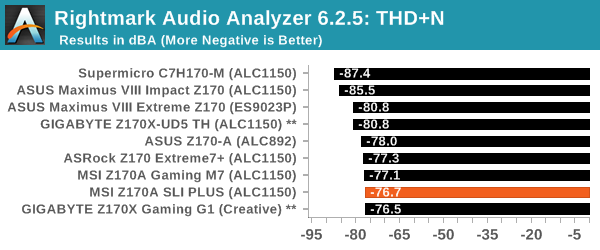
We noted earlier in the review that for a low-cost motherboard, MSI still implemented the Realtek ALC1150 codec with a few modifications like PCB separation and filter caps, but not the big modifications we see on more expensive products. The ALC1150 still performs reasonablt well on SNR, although THD+N isn’t the best we’ve seen.
USB Backup
For this benchmark, we transfer a set size of files from the SSD to the USB drive using DiskBench, which monitors the time taken to transfer. The files transferred are a 1.52 GB set of 2867 files across 320 folders – 95% of these files are small typical website files, and the rest (90% of the size) are small 30 second HD videos. In an update to pre-Z87 testing, we also run MaxCPU to load up one of the threads during the test which improves general performance up to 15% by causing all the internal pathways to run at full speed.
Due to the introduction of USB 3.1, as of June 2015 we are adjusting our test to use a dual mSATA USB 3.1 Type-C device which should be capable of saturating both USB 3.0 and USB 3.1 connections. We still use the same data set as before, but now use the new device. Results are shown as seconds taken to complete the data transfer.

Unfortunately, due to the USB Type-C on the motherboard and my lack of a cable that isn’t cat-chewed, we were only able to run USB 3.0 results in time for the review. This came in at 5.7 seconds, a nice medium between the two collections at 5.6 and 5.8.
DPC Latency
Deferred Procedure Call latency is a way in which Windows handles interrupt servicing. In order to wait for a processor to acknowledge the request, the system will queue all interrupt requests by priority. Critical interrupts will be handled as soon as possible, whereas lesser priority requests such as audio will be further down the line. If the audio device requires data, it will have to wait until the request is processed before the buffer is filled.
If the device drivers of higher priority components in a system are poorly implemented, this can cause delays in request scheduling and process time. This can lead to an empty audio buffer and characteristic audible pauses, pops and clicks. The DPC latency checker measures how much time is taken processing DPCs from driver invocation. The lower the value will result in better audio transfer at smaller buffer sizes. Results are measured in microseconds.
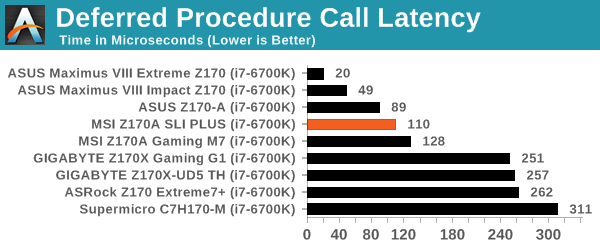
Similarly to POST times, DPC Latency seems to either be quite good or rather bad on the current crop of Z170 motherboards. The SLI PLUS is better than most, hovering just above 110 microseconds at its peak.










62 Comments
View All Comments
BrokenCrayons - Wednesday, April 13, 2016 - link
The value for price proposition of MSI's offering makes motherboards like the ASUS Maximus VIII Extreme look like even more of an impractical absurdity when the performance offered by the added $370 in purchase price is so insignificant that it's utterly meaningless.close - Wednesday, April 13, 2016 - link
The very top of the high end will always be absurdly expensive and with a terrible price/performance ratio. But that's how the high end works. Above a point every extra dollar invested brings in diminished returns.BrokenCrayons - Thursday, April 14, 2016 - link
The problem with that other motherboard is that it's not the very top of the high end. Realistically, it only manages to come up to a rough parity with something quite a bit less expensive. Sure there's a widget here and a goo gaw there that's not included at a lower price point, but the point I'm making is that, despite the difference, its only basically equal which doesn't make that other motherboard high end at all, but overpriced mid range.bigboxes - Wednesday, April 13, 2016 - link
Thanks for your input, random comment man.BurntMyBacon - Thursday, April 14, 2016 - link
@BrokenCrayons: "The value for price proposition of MSI's offering makes motherboards like the ASUS Maximus VIII Extreme look like even more of an impractical absurdity ..."Not sure, but I don't think value or practicality has anything to do with the decision to buy an ASUS ROG board. ; ' )
BrokenCrayons - Thursday, April 14, 2016 - link
Yeah, that's a completely valid point. Not everyone cares about getting a return on their purchase that's meaningfully higher on a set of benchmarks. If that's their thing, then sure, have at it.Ethos Evoss - Thursday, April 14, 2016 - link
Really DON'T understand WHY MB manufs. still implementing ancient ps/2 connectors are they stupid or somethin' /??!?! who uses it nowadays ??Major_Kusanagi - Thursday, April 14, 2016 - link
There are a couple of different scenarios which still require PS/2:1) As a systems admin I've run into systems that won't allow me access to BIOS menus using USB keyboards/mice
2) My 30 year old IBM Model M keyboard is still rock solid, and I'll only part with it when I leave this mortal coil.
random2 - Wednesday, April 20, 2016 - link
Then there are the systems where a USB keyboard/mouse will not function at all until you are able to access the BIOS and adjust the USB legacy settings. No I have no idea why this is still happening. I too have a very old PS2 keyboard I will not let out of my home...ever.skrewler2 - Tuesday, April 19, 2016 - link
since when has it been about performance? the high end motherboards have more features than budget ones.they may overclock better or have some higher end components that purport to offer better stability, but again, features. nothing is directly "faster" or "slower" from motherboard to motherboard.